Oct 25
Planted out the rest of the garlic cloves in various places. Covered the main onion and garlic crop with a layer of leaf mold. Buried coffee can with hazelnut, butternut, and hickory seeds.
Oct 12
Harvested the largest Superschmelz Kohlrabi. It weighed in at 7lbs with the leaves on, 6lbs with the leaves off.


Sep 26
Final weigh-in for Potato Onions is 7lbs and for Winter Squash 22lbs.

Sep 24
We are now fully focused on fertilizing winter crops (Kale, Kohlrabi, Winter Choy). Harvested the lone Early White Vienna Kohlrabi that we brought to maturity. That seed had rather poor germination.

All summer crops have been cut down in-place. Will be focusing on packing some root crops in sand this weekend and storing in 5-gallon root cellars. This mainly consists of potatoes, horseradish, sea kale, and skirret.
Sep 19
Finished the new chicken run this weekend. The post and runners were already set, just had to put up the chicken wire and build a door.

Sep 18
The killing frost arrived last night. Tomatoes, squash, beans, and grapes are all done for the season.


Sep 13
Weighed the Table Queen Acorn squash that we’ve harvested so far, and have 5lbs. A rabbit got into the garden last night and ate all the Winter Choy seedlings as well as the leaves on the Juneberry seedlings. It was due to the fence on the door that was pulling away. Noticed it a week ago but forgot to address it.
Sep 5
Opened a small trench on the shade side of the kitchen garden to heel-in the two remaining Antonovka Apple seedlings and the one Siberian Crab Apple seedling.


Aug 28
Squash and cucumbers are displaying powdery mildew and are likely done for the season. Will cut down most plants this weekend and compost in place. Tasted a small Blauer Speck Kohlrabi last night and it was dry but delicious. Looking forward to the Superschmelz. Planted out the remaining Yellow Heart Winter Choy seedlings earlier this week. Should have enough time to get a good winter crop. Finally have two Golden Honeydew Melons forming, if the frost holds off for a while then we may actually get some ripe fruit.
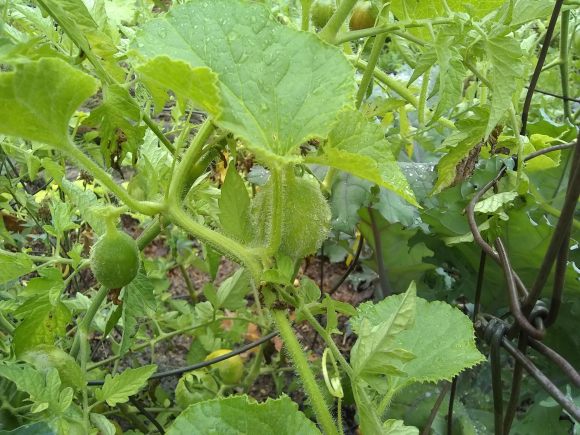
Aug 23
Started working on sheet mulching along the edge of the food forest to push back the grasses and spotted knapweed.

The garden has that wonderful overgrown look now. Winter squash has overtaken all the pathways and the beans have created a living wall along the fence.

Aug 14
Killed two more voles today, one inside the fenced area and one outside. Superschemlz Kohlrabi are starting to size up. The largest is probably the size of a honeydew melon now. The rest are quickly swelling and most are about tennis ball size.
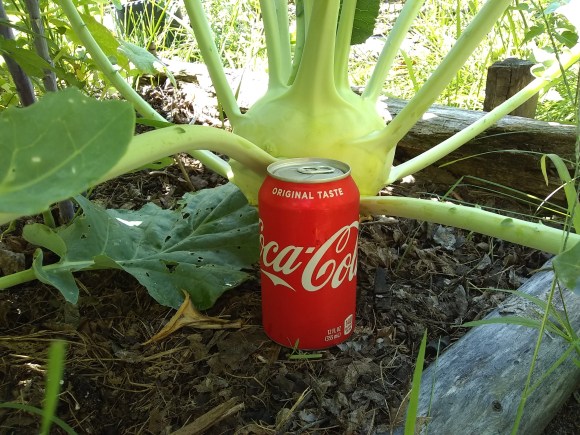
Aug 13
The vole population has been very high this year and as such they have done doing damage to a lot of crops as well as the fruit trees during the winter. Haven’t been very diligent at setting traps, but have started doing so over the past couple of weeks. Killed about 4 so far. The latest kill was last night after I noticed that one of the Turkish Rocket plants was looking extremely wilted and come to find out most of the taproot had been eaten away. I pulled the plant, settled the soil, and replanted it. I have no doubt that the plant will survive, though it’ll probably try to spread more vigorously now.
Aug 12
Cleaned up initial Potato Onion harvest. Total yield is 3.5lbs. This doesn’t include the remaining onions that are currently producing seed. There’s probably at least another pound in the ground.

Overall yield weight probably didn’t improve much from last year. However, the onion size is improving. We have at least a few onions that are between 1.5 – 2 inches in width this year. Next year we’ll focus on fertilization to try and improve yield weight.

Aug 4
We have several Fordhook Zucchini plants growing in different locations as an experiment in soil quality. I’m a little surprised to find that the one that looks the healthiest and has the greenest foliage is actually in the food forest. The food forest soil is generally more depleted than the kitchen garden. The only things going for this plant is that it has a thick layer of leaf mulch and I’ve fertilized a handful of times with urine. Other than that it has had no other assistance.

Aug 2
Cleared some area behind the grapes to begin building in a shrub layer.
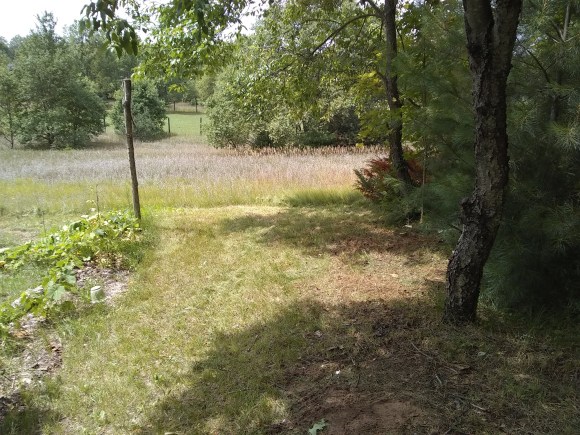
Dug out a hole, amended with bio-char and planted an Americana Dunbar’s Plum seedling. Will either put another plum or an Antonovka Apple at the field’s edge.

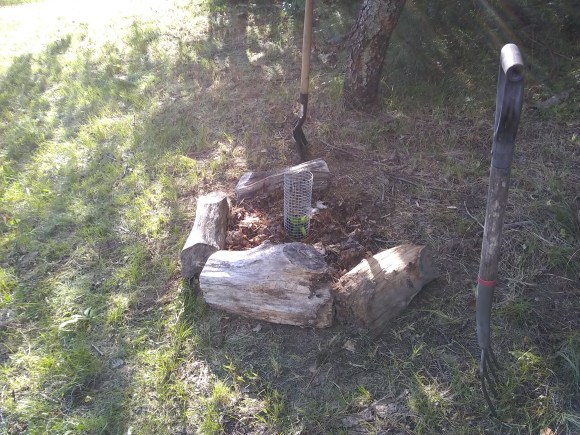

Aug 1
Turned in the north most potato bed. Applied 5 – 10% bio-char into half as an experiment to see soil improvement. Planted two Superschmelz Kohlrabi seedlings and put a row cover over to protect from grasshoppers and rabbits.

The Rattlesnake Beans are developing beans now.
Jul 31
Harvested the remaining potatoes in the upper gardens today. One bed has been decimated by voles. Probably at least a 50% loss. Aside from that it seems like we got a higher number of large potatoes this year. It’s nice to see the seed stock improving. We will be experimenting with bio-char in one of the potato beds. Half of the bed we’ll mix 5 – 10% bio-char and the other half will remain as the control.
Tomatoes are beginning to ripen.
Jul 26
Transplanted 28 Green Mountain Multiplier Onions into the new bio-char plot.
Took down the pea trellis. It takes up a lot of space and casts shade. Will likely just transition to growing peas on the north side of the fence.
Jul 25
Produced 17.5 gallons of bio-char today.
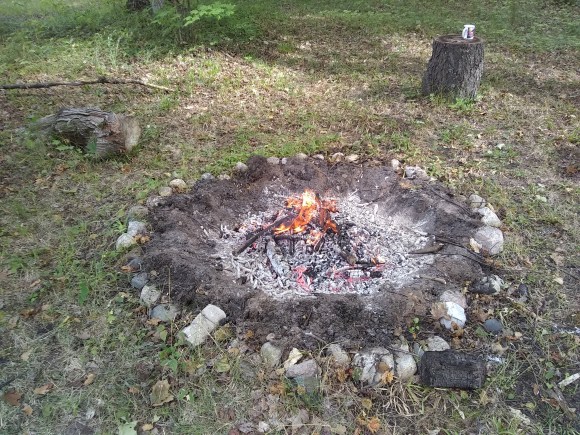

Crushed charcoal by hand, using a wooden club and a plastic bucket. Came out with a product that’s fairly fine but still chunky. Largest particles are about pea size.
Applied about 2 – 2.5 gallons of bio-char to the section where I recently pulled Egyptian Walking Onions from. I’ll be planting the Green Mountain Multiplier Onions in this amended plot tomorrow.

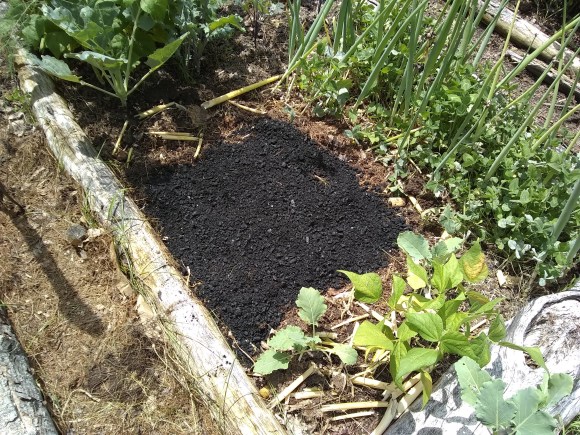
Performed an initial clove count for the garlic that we’ve harvested for this year. Here’s the breakdown on the number of cloves each bulb contained.
| 2 cloves | 8 bulbs |
| 3 cloves | 3 bulbs |
| 4 cloves | 21 bulbs |
| 5 cloves | 10 bulbs |
| 6 cloves | 8 bulbs |
Total bulb count is 50, if I recall from the fall we had planted 54 cloves. That’s a loss of about 7.4%.
Total clove count is 207. From our initial planting of 54 cloves that’s 383.3% increase.
Started harvesting some potatoes that have been dying back over the past week. Yields per-plant are weak as usual, however, we’re seeing a more frequent number of large potatoes. This shows promise for seeding next year’s crop.
Fertilized the trees and support plants in the food forest today.
Jul 19
The first acorn squash has begun forming.
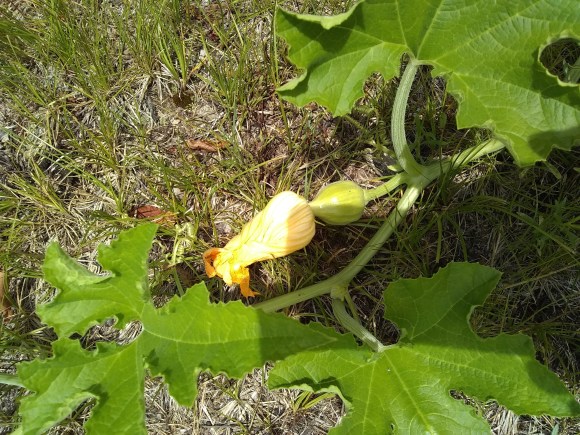
We made our first jar of pickles for the season today.

Harvested half of the Egyptian Walking Onions. Probably over 400 bulbils collected. Going to plant Green Mountain Multiplier onions in the empty space.

Jul 11
Zucchini plants are flowering and reaching full size.

Our best Fordhook Zucchini, which was direct seeded and survived a June frost, has its first fruit developing.

Pulled all the remaining garlic today and prepared it for drying. Bulb size is very small. We usually don’t water or fertilize garlic and this year the long stretch of dry weather impeded the growth and caused the garlic to end its run early.

Cut down the Winter Rye that was growing as a cover crop in one of our potato beds.

Started building out a small guild in the lower garden. Broke up the sod with a mattock and inset some Quaking Aspen logs to create a swale between the two squash mounds. At the north we placed an Americana Dunbar’s Plum and Siberian Peashrub. These will form the shrub layer. The latter will fix nitrogen in the soil. We’ll probably add catmint in as a ground cover. For now we seed Yellow Sweet Clover as a cover crop to fix nitrogen and build up some biomass.


Jul 9
Finally got some rain today, not a whole lot but enough to re-hydrate the landscape. Expected to get about 1″ of rain tomorrow. Noticed while checking the mail a White Sweet Clover growing on the side of the road.

I noticed what I thought was a weed that looked similar to this growing in amongst my Kitchen King Bush Beans. Sure enough, it appears to be another sweet clover. I’ll leave it as it fixes nitrogen in the soil.

In anticipation of the heavy rain tomorrow, I broadcast Yellow Sweet Clover into barren parts of beds as a cover crop. Also tossed some into the Potato Onion bed as those should be finishing sometime in early August I think.
A few of our Golden Honeydew Melons are getting ready to vine. The best performing Superschmelz Kohlrabi is about the size of a tennis ball, I think the consistent 95 degree days have slowed its growth. The tomatoes also seem like they slowed fruit growth during the extreme heat.
Jul 1
Cucumbers and some acorn squash have started flowering today. We’ve been transplanting kohlrabi seedlings under a shade cloth for a fall crop. So far they’re doing great.
Added leaf mulch around most of the winter squash that are getting stressed in the hot weather.
Jun 30
We’ve been in a drought for about a week now. Regular temperatures of 90 degrees each day. Today reached a high of 97 degrees. We had some Skirret plants that got burned due to a lack of water.

We likely need to add more mulch around some plants as they seem to get too easily stressed in the summer heat.
Jun 25
Noticed today that the Northern Prairie Apricot has sprung back from it chopped off stump. Planted out a bunch of remaining winter squash plants in various locations to see how they fare.
Jun 24
Cabbage worms have started showing up on some of the kohlrabi plants. Been picking them off by hand. Our best Superschemlz Kohlrabi is starting to develop a good swell.
Jun 23
Heavy rain last night and through the day today. Squash plants are getting big. Picked our first round of Green Beauty peas.
Jun 20
Squash and cucumber plants have adapted are starting to speed up in growth. Spread a fresh load of manure from the chicken run today. Chipmunks have been digging in the seedlings containers that we leave outside.
The Windsor Fava Beans are looking miserable much like they did last year. Too much pest pressure. Along those lines we’ve seen the arrival of the asparagus beetle this year, many younger ferns have been completely stripped clean by the larvae. I have been cutting these back to the ground and then placing the waste underneath a large pane of glass in the sun. This should get more than hot enough to kill the larvae and any of the eggs they laid on ferns.
Jun 15
A couple large rabbits have started to eat the clover and kohlrabi I have growing in open beds. I replaced the plants and put small chicken wire cages up to keep them out. Today I noticed they also chewed down the tops of one of the hyssop plants. Surprisingly they haven’t really gone after any of the peas.
Jun 14
The first tomato plant has started flowering.

Jun 13
We had an overnight low of 35 degrees with some patchy frost. There wasn’t much frost damage at all since we had the important crops covered up.

Removed sunchokes that were beginning to escape the bed, they were much deeper than expected. Large ones were consistently about 18 inches down. In all, harvested about 2 pounds.
We began harvesting garlic scapes today.
Our cold frame experiment this year has been doing wonderful. The bed is quite a dense assortment of carrots, kale, lettuce, beets, and mustard greens.

The Black Seeded Simpson lettuce still hasn’t bolted despite the extremely hot temperatures that we’ve had recently.

Jun 10
We got some rain overnight, wind gusts are high today. A couple of the stems on the cucumbers have collapsed as a result. Everything else is handling the wind fairly well.
Peas are starting to fall away from the trellis, will need to reinforce them with some twine.
The tray of French Sorrel that I sowed last week has sprouted. Also it looks like the tray of Seaberry is sprouting.
Jun 9
Sunlight wasn’t as strong today but it was hotter than yesterday. Plants all did reasonably well, still covered a number of the winter squash. Transplanted the last 2 Golden Honeydew Melon seedlings. Transplanted most the remaining cucumbers and kale.
Started a container with around 25 Sea Kale seeds.
Garlic scapes have started forming, will likely be ready to cut off by the weekend. Egytptian Walking Onions and Potato Onions are starting to go to seed. Chive is currently in full bloom.
I’ve noticed a number of kohlrabi and a few kale seedlings that slowly fall over and then look like the stem has been reduced in size. I think these may be due to pill bugs girdling the stems underneath the mulch as those are the culprits I found when checking this Superschmelz Kohlrabi.

Jun 8
Used the sprinkler both last night and tonight. Spread diluted urine fertilizer around the garden afterwards. The day was in the mid 80s and sunny. A number of plants appear to have possibly been damaged. Looks like we may have had some kill-back with the mustard greens and lettuce in the cold frame.
These are current progress photos of the two squash hills where we were previously attempting to establish Manchurian Apricots. I’ll be taking regular photos of these every week to track growth.


Jun 7
Cleared the grass at the back of the lower bed and transplanted a line of tomatoes.

Jun 6
Dug another squash pit. Filled the pit with charcoal, wood, and kitchen scraps. Transplanted 3 squash seedlings into the pit.

Jun 5
It’s overcast today. Transplanted 2 Golden Honeydew Melon seedlings. Transplanted the remaining Black Seeded Simpson Lettuce seedlings.
Planted an American Persimmon seed that began sprouting.
Jun 4
Another 94 degree day. Ran the sprinkler for about 10 – 15 minutes to help the plants out a little bit. Replaced a Scarlet Kale that looks like it had a burnt stem. Kept newly transplanted Tronchuda Kale seedlings covered for most of the day as they’re not hardy enough to withstand the intense heat and sunlight yet. The Hawthorne tree in the food forest is looking healthy this year. It’s has more blooms than I’ve ever seen on it and the foliage has little pest damage so far.
Pulled the American Persimmon and American Dunbar’s Plum seeds out of the refrigerator a couple days ago. Planted 1 plum seed in that has begun sprouting.
Jun 3
Temperature is in the mid 80s today. Spot watered any plants that were looking wilted. Am intentionally trying not to water as much as possible in order to reduce leeching in the soil.
Jun 2
Today the temperature reached a high of 94. Had to cover some of the new transplants during the middle of the day. Young seedlings don’t handle these unusually high temperatures well.
Jun 1
Transplanted more tomatoes, kale, and squash. Also planted out 3 sweet potato slips. Started a half tray with lettuce and kohlrabi.
May 31
Last night was our last frost of the season. We attempted to run a sprinkler overnight which may have helped or not as ice just wound up building up on the plants. In any case it was a heavy frost, I was expecting us to lose our potatoes but miraculously they survived under the layer of ice.

All but two of our tomato plants were killed even though many were covered with five gallon buckets. Many of the beans that we had sprouting were killed back. A handful of kale and kohlrabi plants may not make it. Most the growth that was established on the grape vines has been killed back.
None of the fruit trees appear to have suffered any damage. Though the shoots of the Buartblack Walnut seedlings that just started coming out appear to be burned.
Reseeded Rattlesnake Pole Beans and Barnside Runner Beans. Replaced a few tomatoes in the kitchen garden and in the food forest. Planted out several Table Queen Acorn Squash and Tokyo Blue Squash seedlings. Planted out National Pickling Cucumber seedlings.
May 30
Mowed the food forest for the first time this year. Built the first part of the frame for our new chicken run.

May 26
The temperature reached a high of 92 degrees today, as a result some of the more recent transplants were damaged by the extreme spring heat. Thankfully, we thunderstorms rolled in later today.
Most of the transplants appear to be doing well. Slugs are likely the most common source of pest damage at the moment. They’ve only completely defoliated a Scarlet Kale seedling and a Superschmelz Kohlrabi seedling.
What I thought were Beach Plums that had sprouted may actually be Manchurian Apricots, will have to wait a couple years to find out. The Goji berries may actually get well established this year, two of the plants already have about 3 – 4 inches of grow so I put cages around to prevent any deer or rabbit damage.
We’ve been harvesting asparagus for about the past 5 days. I’d say we probably have at least 1 pound at the moment.
The cold frame is exceeding expectations. Mustard greens, kale, beets, lettuce, and carrots are all looking quite healthy.
Rabbits appear to be causing more damage in the food forest this year. They’ve dug slightly under some of the chicken wire cages to either get at tree seedlings or onions that we’ve planted. They’ve also completely destroyed one of our Eastern Prickly Pear cacti. If rabbit pressure holds up, hunting may be an option in the fall.
Food forest trees are looking great, even the apples have decent foliage so far. The Tolman Sweet Apple is starting to push out buds. All the trees that were debarked by voles (save for the Methley Plum) still look relatively good though the Toka Plum doesn’t appear as vigorous as last year but it’s still early in the season. The Montmorency Cherry up by the kitchen garden doesn’t seem to be flowering as heavy this year.
The grape vines are now fully leafed out.
May 19
Transplanted seedlings have all held rather well and I’ve only seen pest damage, which I attribute to slugs, on one of the Scarlet Kale seedlings. Initial plantings of carrots and parsnips appear to all be coming up now.
Started 4 pots of Golden Honeydew Melon with 3 seeds in each container.
May 18
Received 8 Eastern Prickly Pear Cactus pads in the mail today. Transplanted some kale, kohlrabi, and a tomato plant into the food forest as an experiment to see how they’ll do this year.
Moved Hybrid Willow cuttings into a container with soil to develop the roots more before transplanting into the food forest.
May 17
Felled and started peeling Quaking Aspens logs to use for constructing our new chicken run. Direct seeded some winter squash in various places outside the fenced garden.
May 16
Constructed new welded wire cages for the trees out in the food forest. Transplanted kale, kohlrabi, skirret, and tomatoes into the garden. It was a warm day and heavy rain is expected for the next couple days.
Transplanted Hyssop next to the Somerset Grape and Catawba Grape.
May 12
The Reliance Grape cutting appears to be forming roots now. Hybrid Willow cuttings are rooting quite aggressively now.
May 11
Received 12 Giant Miscanthus rhizomes in the mail today. Placed in some potting mix to begin rooting.
May 9
Started Winter Savory, Stinging Nettle, and Marigold seeds in trays.
May 8
Divided the 4 Siberian Crabapple seedlings into separate containers.
May 7
Received 10 Hybrid Willow tree cuttings in the mail today. Some were already rooting all along the stem. Placed in a jar of water to develop roots.
May 6
The direct-seeded kale that we had appears to have mostly been killed by a frost last night. Tadorna Leeks appear to be okay. The lettuce in the cold frame is beginning to develop its first true leaves. Planted a Tolman Sweet Apple tree today that I ordered from Stark Bros. It went in place of the Methley Plum that was debarked. The Methley Plum had some sprouts below the soil line but I’m unsure if they’re from the root stock or the graft so I replanted it to see what we get.
May 5
Tadorna Leeks have adapted well and are surviving overnight freezing temperatures. Blauer Speck Kohlrabi and Superschmelz Kohlrabi are beginning to develop their first true leaves. Beets, carrots, kale, lettuce, and mustard greens have all sprouted now in the cold frame.
The Reliance Grape cutting is showing signs of callusing so I’ve pulled it from the growing container and placed it in a jar of water to see if it’ll develop roots now.
Started a tray with Cocozelle Zucchini, Table Queen Acorn Squash, Tokyo Blue Squash, Nasturtiums, National Pickling Cucumber, Black Seeded Simpson Lettuce, and Big Boston Lettuce.
Checked on the seeds in the refrigerator. Many are starting to get mold on them. Pulled the Arctic Beauty Kiwi (Actinidia kolomikta) into a small tray to see if they’ll begin sprouting.
May 3
Built another leaf bin, this time down by our basement. Transplanted 3 Antonovka Apple seedlings into a large coffee can filled with compost, chicken manure, and charcoal. Direct seeded Blauer Speck Kohlrabi and Superschmelz Kohlrabi throughout the various garden beds. Left the tray of Skirret seedlings outside last night and some animal (a bird I think) pulled out a couple of the seedlings.
May 2
Transplanted the Skirret seedlings into cups.

ECOS Pear seeds that were planted in the garden have started emerging.

The various apple seeds are emerging also.

Green Beauty Peas are pushing up through the mulch. This will be the first year that I’ve grown peas with a heavy layer of mulch still on the bed.

Constructed a leaf bin today. We’ll let this set for probably a year, after which we should have some good leaf mold.

May 1
It was a high of 74 degrees outside today. Got all the plants outside in direct sunlight with a light wind. Patches where we direct seeded kale and peas are all sprouting now. The transplanted Tadorna Leeks seem to be doing alright. Will plan on transplanting the rest this weekend.
Asparagus spears are beginning to poke through in both the garden and the food forest.

Apr 29
Moved 4 Skirret seedlings from the tray into cups to allow for continued root development.
The Methley Plum cuttings haven’t been looking so good. They wilted and have many spots of fuzzy mold. Checked the bottoms of the cuttings and it doesn’t appear that any have formed roots or even callused. The experiment is likely a complete failure. There’s a couple things I’ll try differently next time. First I believe my soil medium was likely too moist, which didn’t really the encourage the cuttings to root and instead made them focus on leafing out too much. I also probably should’ve used some sort of bottom heat to encourage callusing. The next cuttings I try rooting will have the top ends sealed with wax to prevent drying out and then bottom ends will be packed in moist peat moss with bottom heat applied. Using the bag over the container just seems like it causes the cuttings to leaf out and grow mold more than anything.
My Reliance Grape cutting is currently leafing out and has a little mold on one of the leaves. I’ve made some slits in the bag to reduce humidity a little bit. I also moved the cutting to the rear of the top of the refrigerator in an effort to try and give it more heat.
Apr 28
Was a fairly sunny day today, managed to get all the plants outside again. Transplanted 3 Tadorna Leek seedlings into a bed. We are expecting some freezing temperatures next week so I’ll be keeping them covered with a humidity dome for a while.
Apr 27
So it looks like I was wrong. The St. John’s Wort that I planted never came up, it was the Skirret that came up. This actually makes me happy as I was really looking to getting Skirret started as a food crop this year. Below is a picture of what the Skirret seedlings look like.

Started 55 Siberan Peashrub seeds in a small tray.
Apr 26
Did some pruning on cherry, pear, and apple trees today. Put a large cage around the Alderman Plum, if I don’t the deer will make me pay dearly for it.
Apr 25
We discovered a few parsnips from our failed crop last year that wintered over. Rather small but still delicious. Will see if we can get them all the way to seed.

Apr 24
Got most of the seedlings outdoors today. Tomatoes are getting big and starting to fall over. Been transplanting them into new containers as needed.

Dunstan Chestnut seedlings are leafing out more.

The Red Russian Kale and Scarlet Kale seedlings have all emerged. Early White Vienna Kohlrabi is taking a while to sprout.

Harvested our first Egyptian Walking Onion of the season. This was from a plant that had divided into three. Cut off the bottom and replanted in another bed.

Apr 21
Started a tray of Blauer Speck Kohlrabi, Superschmelz Kohlrabi, Tronchuda Kale, and Turkish Rocket.
Apr 20
Set trays of tomatoes, kale, and chestnut trees outside today to begin hardening off.
Apr 19
Of the 50 Elephant Garlic corms that we planted in the fall, it looks like the first one has emerged.

Apr 15
Cold frame reached a high of 81 degrees today without being vented. We put a heavy duty tarp over the bed to prevent it from getting too cold at night. Maintained an overnight temperature of 32 degrees while outside
temperature was 17 degrees. Weather is supposed to start warming up this weekend, so hopefully we’ll see kale seedlings emerging sometime next week.
Apr 14
Started a tray of Early White Vienna Kohlrabi, Red Russian Kale, and Scarlet Kale today. I’m making an aggressive effort to successfully grow Kohlrabi this year.

The Methley Plum cuttings are now 4 weeks in and leafing out. In another 4 weeks we should be able to reduce the humidity and then check for root development. Hoping to get at least a 30% success rate on this propagation.

Finally took the dome off the tray of Tomato, Lovage, and Tadorna Leek seedlings. The leaves of the tomatoes are a little windburned from being outside the other day but they’ll recover in no time.

Checked on the temperature of the cold frame to see how it’s doing. Was at about 50 degrees midday while the outside temperature was around 26 degrees. Overnight low so far is 27 degrees.

Apr 12
Discovered today that I may have accidentally cut the good cane off of my Reliance Grape when I was pruning the other week. The cutting was still green and not dried out so I snipped the ends, dipped it in rooting hormone and placed it in a container with a plastic bag over it. Hopefully, it may root and I’ll get another grape vine out of it.

Apr 11
It was a sunny, windy, but mostly warm day today. Leaves were dry enough that I was able to shred a couple piles to fill half of a bed that was still uncovered.
A couple of the Glaskins Rhubarb seedlings I started last year are beginning to come up.

Potato Onions have been staying strong with all the cold weather.

Won’t be long before we’ll be harvesting some Egyptian Walking Onions. These are always my earliest onion in the spring.

Making an effort to utilize every available space inside and outside of the fenced garden that I can. Finally put some logs to border the bed on the right hand side of this photo. We planted our excess Green Beauty Pea and Admiral Soup Pea seeds in this bed.

This is our strongest Sea Kale seedling so far. I’m interested to see how well it does this year. I recently purchased more Sea Kale seeds on eBay from a seller in Canada.

We took the opportunity to make a quick and dirty cold frame today. Used some old scrap lumber and patio windows that were left on the property from the previous owner.

After assembling the frame, I flipped all the sod over with a garden spade.

Raked out any significant clumps and then amended with some shredded leaves and chicken run material. We wound up planting a mix of beets, carrots, kale, lettuce, and mustard greens in the bed.

Apr 9
Weather has been flip-flopping back and forth between rain and snow during the past week. Managed to get outside yesterday and takes some pictures of how spring crops are progressing.
Another welcome surprise, I wasn’t expecting Good King Henry to emerge this early in spring.

Victoria Rhubarb starting to push out more leaves.

Turkish Rocket is one of the crops I’m most anxious to try as it’s a perennial member of the Brassica family.

For some reason I thought Caucasian Mountain Spinach would be a little more frost intolerant but this cold weather certainly isn’t slowing it down.

Apr 5
Direct seeded Dwarf Sugar Ann Pea, Admiral Soup Peas, Windsor Fava Beans, Red Russian Kale, and Half Gurnsey Parsnips.
Located two more Sea Kale seedlings that survived the winter. Also started a planting box made from some Quaking Aspen that I milled during the winter. Seeded Scarlet Kale, Siber Frill Kale, and Thousand-Headed
Kale into the planting box. Placed the planting box in our makeshift cold frame, which is an old bathtub with a patio window I place over it at night.
Apr 4
Planted Green Beauty Peas today. Cherry trees are getting close to leafing out, the Juliet Cherries are the furthest along. I expect them to be the most vigorous growers in the food forest this year.
Apr 2
I noticed today that it looks like all the Turkish Rocket seedlings from last year have already started coming up.

I’ve determined that Scarlet Kale is the most hardy variety of kale we’ve ever grown. The plants from last year are already beginning to send out side shoots. Unlike the Thousand-Headed Kale, the stalks of the Scarlet Kale survived the winter practically unscathed.
The St. John’s Wort has started sprouting.
Mar 31
The Victoria Rhubarb the I planted last year is already starting to emerge.
Mar 29
Replaced an old fence post that’s about 4 – 5 years old. Lasted a good while considering it’s aspen and I didn’t protect the bottom part of the post. The new post is red oak. I wrapped black plastic around the base to keep the soil from making contact with wood at ground level. That’s the area where rot usually occurs.

Was able to locate the other 2 Caucasian Mountain Spinach seedlings. It looks like the Sea Kale seedlings from last year survived. I found one that a fairly decent root developed and moved it into the corner of my main asparagus bed.
Dug out a large Comfrey plant from the bed where I usually grow peas. Broke the root apart and planted in various areas.
Mar 28
Planted the 2 remaining Buartblack Walnut seedlings at the top of the hill. Moved a Chickasaw Plum seedling so that it’ll be a shrub layer in front of the Buartblack Walnut.
Looking down from the upper part of the hill.

Shredded leaves to place on top of the second potato bed.

The Music Garlic has started poking through the mulch.

Mar 27
Spread manure on our second potato bed today. Also shredded a load of leaves and placed that on top of the manure layer.
Last fall I originally transplanted 4 Buartblack Walnut seedlings at the bottom of our sloping hill. I believe I made a mistake in doing this, as it may create too much shade on the hill and prevent us from successfully growing crops there. With that in mind I moved 2 of the seedlings up the hill to establish a canopy as far back as I can. The initial tree/shrub layer in front of the Buartblack Walnut will consist of Americana Dunbars Plum and Chickasaw Plum.
The two cages in the back of this photo are the Buartblack Walnut seedlings.

Last summer I planted out 3 Caucasian Mountain Spinach (Hablitzia Tamnoides) seedlings. Two I haven’t seen any sign from yet, but my strongest seedling is already re-emerging and sending out new shoots. It’ll be nice to have a perennial spinach-like green without the fuss of starting seeds every year.

Mar 25
Hauled the first load of manure out of the chicken run and laid on top of a bed where we will be growing potatoes and beans this year. I’ve never companion planted anything with potatoes but I’ve noticed that bush/pole beans work as a great companion for just about any plant. I routinely plant beans in between my tomatoes. This fixes nitrogen in the soil and the beans also serve as a living mulch, keeping the soil beneath cool and free of weeds.
My quick air prune bed design from the fall has experienced a failure. I didn’t secure the hardware cloth on the bottom using wooden rails and thus the staples failed and the hardware cloth is now sagging. One bed I lost a good bit of bottom material from but both beds are still intact, they just likely won’t have the intended air prune effect.
Started raking leaves to use for mulch, winter onset so quickly last year that most of the leaves are still on the ground. We will shred the leaves using our wood chipper and then lay them on garden beds that aren’t fully covered.
The Music Garlic we have planted is beginning to poke through the mulch, also noticed a couple of our Rhubarb plants are getting ready to push out leaves. I checked on the Elephant Garlic corms we planted in the fall and so far I haven’t seen any signs of rooting, though it did look like the hard shell on the corms have split.
The Thousand-Headed Kale and Scarlet Kale appears to have overwintered well. Scarlet Kale stalks have mostly retained their color and firmness as they’re the hardier variety. The stalks of the Thousand-Headed Kale are bleached white. I imagine for those most of the stalk is probably dead, though the plants should still send out new shoots from the base if that’s the case.
Mar 22
Started seeds today for Skirret and St. John’s Wort.
Pulled seed potatoes out of the 5-gallon bucket root cellar. Potatoes are in good condition, don’t see any that were compromised by mold or rot.


Mar 20
Started seeds today for Abe Lincoln Tomato, Black Krim Tomato, Black Vernissage Tomato, Chadwick’s Cherry Tomato, Pink Bumblebee Tomato, Tadorna Leek, and Lovage.
Planted some Russian Tarragon seeds in a can.
Mar 16
Salvaged 12 cuttings from the Methley Plum and planted in a container to see if they’ll root.
Only about 5 – 6 are good hardwood cuttings so realistically I’m expecting to get maybe 2 or 3 successful plants.

I cut the lower ends of the cuttings at a 45 degree angle to increase the surface area. The ends were then dipped in rooting hormone and placed into potting mix. Placed a zip-lock bag over the cuttings to maintain a high humidity level.

Mar 15
Placed Arctic Beauty Kiwi (Actinidia kolomikta) seeds in the refrigerator for stratification.
Checked on the food forest and several trees were damaged by voles over the winter.
The Methley Plum has been completely girdled. The best thing I can do is try and root as many cuttings as I can get off the tree.

The Northern Prairie Apricot was completely debarked. This plant still has a good root system and has regrown vigorously after being cut down by deer a couple years ago.

The Bartlett Pear, Superior Plum and the Toka Plum were also damaged but I believe these trees may be able to heal and survive.
Mar 7
Placed 27 Hybrid Siberian Crabapple (Malus robusta) seeds in the refrigerator for stratification. Based on research this variety is a cross between Siberian Crabapple (Malus baccata) and Plumleaf Crabapple (Malus prunifolia). One source says the common name is Cherry Crabapple, that’s
what I’ll likely refer to it as going forward.
Progress on the can with Antonovka Apple and Siberian Crabapple.

Progress on the can with Siberian Crabapple, there’s five seedlings but one looks like it may not make it.

Mar 5
Blue Hyssop seeds have started sprouting. Placed 30 Sargent Crabapple and 10 Spice Bush seeds in the refrigerator for stratification.
Feb 28
Planted around 10 Blue Hyssop seeds in a can.
Feb 24
Placed 15 Winter Gold Crabapple seeds in the refrigerator for stratification.
Feb 23
Placed Seaberry and Lingonberry seeds in the refrigerator for stratification. The first two Dunstan Chestnut seedlings are starting to leaf out.

The Siberian Crabapple seedlings have started sending out their first true leaves.

Feb 16
Removed the remaining 5 Antonovka Apple and 6 Siberian Crabapple seeds from the refrigerator and planted in a can.
Feb 15
Removed the remaining 9 Dunstan Chestnut seeds from the refrigerator and planted in cups.

Placed 10 American Persimmon and 29 Americana Dunbar’s Plum seeds in the refrigerator for stratification.
Feb 11
Siberian Crabapple seedlings have started emerging.

Removed five Antonovka Apple seeds from refrigerator and planted in a can. Placed 50 Hardy Kiwi, 25 Juneberry, and 25 Saskatoon seeds in the refrigerator for stratification.
Feb 8
Checked on the apple seeds in the refrigerator. Planted five Siberian Crabapple seeds that had sprouted.
Jan 26
The Dunstan Chestnuts have begun to sprout in the refrigerator. One was compromised by mold. Pulled two out and planted in containers.
Jan 11
The hens have started laying. Collected three medium light-brown eggs today. I’m guessing they’re from the Golden Laced Wyandotte hens as I’ve read Welsummer eggs tend to be speckled.
